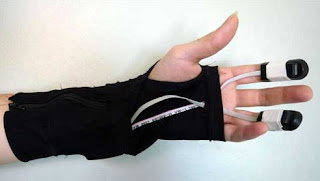The institute for Art and Design and the University of Applied Science Northern Switzerland spent five weeks observing the reactions of visitors to a special exhibit at the Kunstmuseum St. Gallen. The goal was to obtain new insight into the emotional and cognitive reactions of visitors to the art objects.
Upon registration at the museum entrance, visitors receive a special glove, which is equipped with biometric sensors and an active Ubisense tag. The exhibition is equipped with 20 Ubisense sensors that can locate the visitors positions with an accuracy of 15cm, as they move through the exhibition. In parallel the heart rate and electrical conductivity of the skin is measured and sent to the central server, which receives and analyses the results. At the end of the exhibition, visitors can view the results on a plasma screen showing their emotional excitement levels during the exhibition as well as other interesting data.
 |
| A glove wearing visitor |
‘’We are delighted with the performance of the Ubisense tracking system’’, declares Roland Waespe, director of the Kunstmuseum St. Gallen. ‘’Our museum building presents a number of architectural challenges for radio based systems and we have been impressed with the reliability and precision of the system in this environment’’.
Research
Ubisense RFID tags transmitted the location data to Ubisense Series 7000 sensors, then forwarded that information to Ubisense’s Location Platform, that exported the captured data to other applications. The biometric data was transmitted via wireless LAN to MySQL database, where it was merged to location information. The location data was then used to determine which specific artworks the visitor had been viewing, how long that individual had looked at each piece. By comparing the biometric data, the researchers could measure a participant’s biological and cognitive reaction to each work of art.
It was found that more educated and elderly visitors had much more interest in classical works of art, whereas younger visitors, tended to be more stimulated by newer, more abstract works.
© Copyright Ubisense 2011



No comments:
Post a Comment